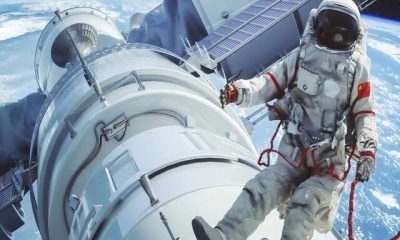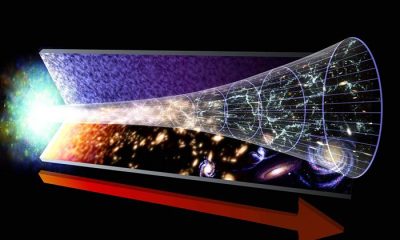Physics
time travel , Is it possible to travel in time right now?
Published
1 year agoon


While traveling to the future is possible at approaching the speed of light, every time scientists find a way to travel to the past, a law prevents it from happening. Is travel to the past forbidden in our world?
A famous Iranian proverb says, “water that has been spilt cannot be collected.” I don’t think anyone wants to question the logic of this statement, but have you ever wondered why the water that spills so quickly from the glass to the floor doesn’t just as quickly go back into the glass? If we have filmed the water spilling on the floor, we can reverse the video playback and watch the water go back into the glass; It’s like time has turned around. But in the real world and despite countless attempts throughout history, unfortunately, the phenomenon of time travel has yet to be able to leave the realm of science fiction.
At the outset, we are not entirely ignorant of time. For example, we know that the dimension of time is intertwined with the other three dimensions of space and forms the four-dimensional theropod of the universe. We also know that the passage of time is relative. Depending on what our frame of reference is, we can travel to the future very slowly and quietly. For this, it is necessary to approach either the speed of light or a black hole. But well, the failure of these two cases is due to engineering limitations, not the laws of physics.
Is time travel possible?
To be able to travel in time, it is necessary to create conditions so that we do not feel the passing of every single second. According to the hypotheses, to travel to the future or the past, we must have one of the following three states about the current rate of time passage:
- Travel faster than the current rate of time passing: By doing this, we can travel into the future while still being at our present age.
- Move slower than the current rate of time passing: then we can do more in a given amount of time than other people.
- To move so slowly that time becomes negative for us: by doing this, we travel back in time, and we can change the current situation by doing things in the past.
Time travel in all three cases mentioned seems entirely science fiction, But this does not mean that traces of science cannot be found in them. As far as we know, traveling to the future may be possible someday with the advancement of technology. Still, we cannot reverse the direction of the flow of time. This inability is not due to the limitations of engineering but rather the laws of physics that seem to bind us. All the evidence indicates that traveling back in time is forbidden in our world. Every time we try to build a time machine to travel back in time, a law of physics gets in the way and destroys all our plans.
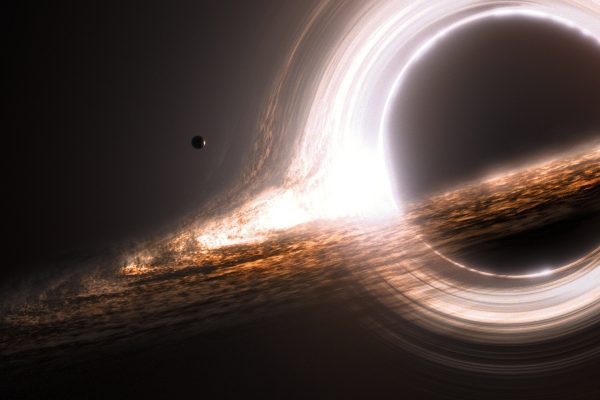

However, we still need to understand the main reason for banning time travel. No basic concept, law or equation can explain with certainty and 100% why travel to the past is prohibited. All the reasons we face building a time machine seem entirely random and unrelated. It’s clear that the universe is trying to tell us something important about time travel, but we don’t understand its language. And since we are still not wholly convinced that time travel is 100% forbidden, we continue to try to understand this and build a time machine.
Special relativity: travel to the future; general relativity: travel to the past
When Albert Einstein proposed the theory of special relativity in 1905, one of his most surprising concepts was that every object with mass in the universe must travel through time. Another surprising implication was that time is entirely meaningless for the photon or any massless particle. Because from the moment a photon is emitted, it hits an object, only observers of the thing, including us humans, can observe the passage of time. But from the photon’s point of view, the entire universe, which is in its path, gathers in a single point, and the radiation and absorption of the photon both happen simultaneously and instantaneously.
Anything with a mass in this world cannot move at the speed of light in a vacuum. It will always be slower. Another point is that it doesn’t matter how fast we move relative to other objects; The speed of light will always be constant. This remarkable observation also has a surprising consequence. If we watch another person’s movement towards us, their clock seems to pass more slowly.
In the same way, our clock ticks more slowly in the eyes of the person watching us. Both cannot be true simultaneously; when we meet, one will be younger than the other. But which one?
The paradox of twins; What does relative time mean?


An interesting theory known as the “twin paradox” in the discussion of time travel was first proposed by Paul Langevin in 1911, which is based on Einstein’s theory of general relativity. However, neither Einstein nor Langeun believed that the essence of this theorem was a paradox.
Einstein expresses the paradox of twins as follows:
Take two people who are identical twins and give them equal hours. Person a decides to travel through space at speed close to the speed of light, while person b does not intend to travel anywhere and stays at home. These two people can see the status of their watches. Person b, staying at home, observes that person a’s clock is ticking slower due to traveling at a very high speed and the phenomenon of time dilation. Person b concludes that time has passed more slowly for person a, so person a must be younger. Now let’s examine the situation from the point of view of person a. We know that time dilation depends on relative mass motion. That is, person a observes that person b’s clock moves slower and concludes that person b is younger. Now, the person returns home. What situation do these identical twins observe? Indeed, both views cannot be accurate at the same time, and only one has remained younger while the other has become older. But which one?
To answer this question, we must refer to Einstein’s theory of general relativity. According to general relativity, time passes more slowly for someone who moves in an accelerated manner, and this means that he stays younger compared to someone who does not move in an accelerated way. So someone who stays at home and doesn’t move quickly experiences the passage of time at a standard rate. As a result, the person who remains younger and returns home as if he travelled to his future and sees his adult life in his twin brother or sister is person a.
If we want to travel to the future, it is enough to move with speed close to the speed of light and, after some time, return to the first point, where the passage of time has passed faster. We continue moving at the speed of light for decades, centuries and maybe billions of years and then return to our original place. We can observe the evolution and destruction of humans, witness the death of the Earth and the sun, and experience one of the four scenarios of the end of the universe. As long as our spacecraft has fuel, we can travel as far into the future as we want.
traveling to the future is physically possible and proven, but the problem is engineering limitations; We cannot travel to the future until we can approach the speed of light. But traveling back in time is an entirely different story. While special relativity, or in other words, understanding the relationship between space and time in the simplest possible state, is enough to go to the future, to go back to the past, it is necessary to go to general relativity. It means the relationship between spacetime, matter and energy. In this case, space and time are intertwined, and we do not consider them separately. Matter and energy are also factors that cause bending and changes in the theropod of spacetime. In the following, we will tell you why traveling to the past seems impossible and why scientists have not given up on finding a way to make this wish come true.
Relax; kill your grandfather
In confirming and denying the possibility of traveling to the past, all kinds of philosophical discussions have been raised; For example, the very famous “Grandfather Paradox” and even Christopher Nolan referred to it many times in the winding film “Tenet”. They tried to explain it most simply.
In the “Grandfather Paradox” scenario, we assume that we managed to build a time machine and travel back in time with it. There we see our grandfather when he is still a child. We decide to kill him (the motive of the murder is not clear, but that’s how it is written in the scenario). But wait! Now that our grandfather died before our parents were born, it means that we won’t be born either. Therefore we can’t travel back in time and kill our grandfather! So, is grandfather dead or alive now?
One theory proposed to solve the grandfather paradox is that we may be allowed to travel back in time, but what we can do in the past is limited. Maybe the past will always exist in the same way we remember it, and nothing will change it. For example, every time we try to shoot our poor grandfather, the bullet gets stuck in the gun’s barrel, and he survives! According to this theory, nothing is new because all these events have happened in the past. That’s why we can’t kill our grandfather in the past, because we didn’t do it then. However, we may be able to arrange the visitation of our grandparents, as this visitation is in line with the events recorded in the future.
But maybe there is no such thing as time at all! Perhaps the time is the only conscious creation of man to organize and organize the inputs of our perception. Maybe we are trying to impose a deep and fundamental concept to the world for which time is unimportant, and this whole discussion is useless.
All these debates are raised in philosophical circles. But let’s see what physics has to say about time travel. Anyway, suppose we can even make a time machine on paper. In that case, we can change the course of the whole world in the way we like, Or, finally, buy Apple shares when each share was worth only 22 dollars and roll in the money now. It’s worth it, isn’t it?
Travel to the past with a closed time curve


Physicists use particular language when they try to build a time machine. We mean the language of gravity, which the great Albert Einstein gave us under the title of “general relativity”, and it is actually the story of bending and how objects move in spacetime.
In general relativity, matter, say the Earth, tells spacetime how to curve around it, and the curvature of spacetime tells matter how to move through it. To find out if we can build a time machine, we must first see if it is possible to make spacetime. That is, we have to find a unique arrangement of matter in spacetime that allows us to travel back in time.
For this, we need to find some kind of “closed time curve” (CTC). “curve” means a path between space and time. “Timely” means that there is no fraud and cheating, and we are not allowed to exceed the speed of light at any point in this experiment. “Closed” also means that the curve ends at the same point where it started, and its top and bottom are the same. Imagine that you are moving in the same direction, always forward and never faster than the speed of light. Still, at the end of the journey, you will return to your starting point, or past, as if you had moved not on a straight path but around a curve.


The strange thing about this story is that the closed time curve exists! Over decades of experiments and studies, we discovered many facts about general relativity that make time travel possible, Including.
- Kurt Gödel, the famous mathematician (yes, the one who, due to extreme paranoia, only ate food prepared by his wife, and because his wife was in the hospital for six months, starved to death), discovered that if we have a world full of A single, slowly swirling dust, paths can be found in that world that leads to their past.
- Are you familiar with wormholes? The same shortcuts in space? Wormholes act like a kind of time machine. To make a time machine out of a wormhole, we need to grab one of its heads and hold it firmly. Then take the other end and bring it close to the speed of light. Now we glue this end to the other end. The two ends of this wormhole no longer have simultaneous clocks because as Einstein approaches the speed of light, time dilation occurs. That is, the faster we move, the slower time passes, and because of this, the time at one end of the wormhole is now behind the other end. In other words, this head is placed in the past of the other head, and jumping into the wormhole makes time travel possible.
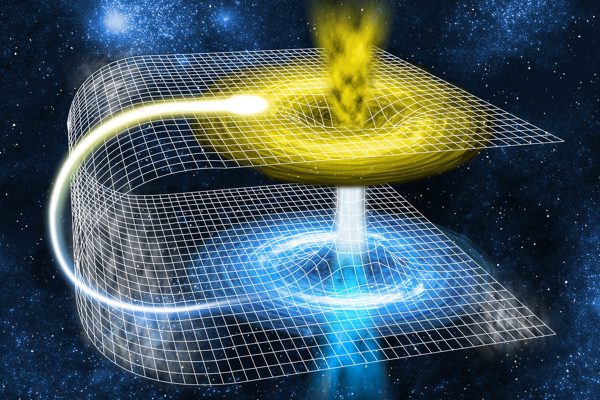

- Suppose we have a cylinder in spacetime that continues to infinity (known as Tipler’s cylinder in physics), and we are rotating this cylinder in its longitudinal axis until close to the speed of light. Now, if we ride a spacecraft around this rotating cylinder at the speed of light, we can travel back in time!
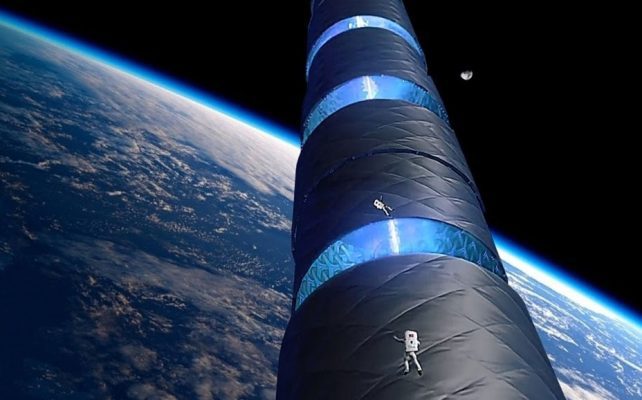

- The spinning black hole rune is also a fascinating place. Here the opposing currents of gravitational and centrifugal forces meet to create a bottleneck at the centre of the open black hole and the possibility of a closed time curve.
Failures in time
Of course, there are other examples of the closed time curve or the same time machine, but I think you have understood the meaning by now. All these examples are inspiring because they show that the theory of general relativity, which has been tested and validated over a century, predicts the existence of a time machine! Of course, under very, very special conditions.
Because observations of cosmic background radiation, the light left over from the universe when it was only 380,000 years old, show that our galaxy is not rotating. There is no infinitely long cylinder at work. A singularity is also happening inside black holes, and it tells us that the mathematical logic of general relativity is breaking down and cannot be trusted. Wormholes are also highly unstable, so an impossible photon passing through their throats causes them to collapse faster than the speed of light. Efforts to stabilize wormholes require a material with negative mass, the existence of which is as controversial as time travel itself.
This is where physicists get confused. General relativity tells us exactly where in the world it is possible to travel to the past, But every example we propose for time travel faces problems that have nothing to do with the mathematical logic of general relativity. There is no coherence or logical relationship between them.
Suppose our inability to travel back in time is a fundamental part of the universe. Shouldn’t there be equally essential laws for this inability to justify its impossibility? The reality is that every time general relativity predicts a new closed time curve, there is a legal screw-up that makes time travel impossible. In other words, there is no single, solid link connecting all these reasons why time travel is forbidden. Still, the bottom line is that under no circumstances should time travel be allowed. What is the story?
Is time travel possible؟ The arrow of time is stuck
Now that we have made no progress in constructing a closed time curve despite the predictions of general relativity, it seems that time travel is forbidden. But proving this ban is another story. To explain why time seems to always move in only one direction, like an arrow from a bow, we need help from other areas of physics.
The first thing that comes to mind is to go to fundamental particle physics because it’s “fundamental”. But once you get into this realm, things get even messier because almost every interaction in particle physics (and practically all physics) is complete, without exception, and symmetric in time. That is, all the events that happen to the particle in one direction can also occur in reverse in the other direction, and particles do not discriminate in this case. For example, if you take two subatomic particles and smash them together and then watch a fireworks display afterwards, you will notice that the particles after this collision and being thrown in random directions tend to collide with each other again and make new particles. In other words, as much as the particles tend to move forward (i.e., split upon impact), they also like to move in the opposite direction (form new particles upon impact).
To summarize: for particles, there is no concept of past and future, and there is no time arrow that only moves in the forward direction. For this issue, an example can be given on a larger scale. For example, I will play you a video in which it seems that an apple is flying from my hand, But how do you know I wasn’t playing the video in reverse for you? I was catching the apple that was thrown into the air. I don’t think you can tell the difference between the two in the video. This inability to distinguish between forward and backward movement means the past and future are irrelevant.


As far as we know, fundamental physics does not care about time, as if time is not defined for it. However, we are experiencing the flow of time from the past to the future, and the passage of time is as real and tangible to us as the greying of hair and facial wrinkles. As a result, to solve the problem of time travel, fundamental physics is not helpful, and we must enter another field in physics; an area called statistical mechanics and the sweet topic of entropy.
Entropy; Clean your room!
In the universe, there is one thing for which the direction of the arrow of time is essential and violates time symmetry. Two things, but the first one, related to some weak nuclear force interactions, is an infrequent phenomenon and far away from our everyday experience of “time”. Therefore, it does not seem that the secret of time travel can be discovered in the weak nuclear force.
But the second case, which brings us back to the first proverb of the article and the spilt water that cannot be collected, is the issue of entropy or chaos; by the way, Christopher Nolan had a special devotion to this issue in the movie “Tent”. Still, it’s a pity that his explanation of entropy is. It is not as simple and understandable as the grandfather’s paradox.


Let us give a simple example of this complex concept. Consider an egg that falls to the ground. As time progresses, the egg breaks (becomes more disordered) but never returns to its original healthy state (less disordered). The flow of entropy is the only thing that does not allow the broken egg to become healthy again because, as we have explained so far, all the laws of physics around us have time symmetry, and for them, moving forward and backwards in time is no different; It means that anything that can happen on can also happen backwards. The laws of physics allow the egg to return to its healthy state, but entropy prevents it.
Entropy says that all systems in the universe tend to go from an orderly (and healthy) state to an irregular (and broken) form, and this is because of the back-breaking power of statistics and probabilities!
How many ways can we have a perfectly neat and orderly bedroom? Just one. All clothes should be neatly folded and placed in the drawer. Not even a speck of dust should be on the table and cupboard. The bedding should be smooth and neat. Everything should be in place. If you want to arrange your room, you have no other way.
But how many ways are there to have a dirty and messy bedroom? Countless! Pizza boxes under the bed. The socks are on the floor. The sheets are wrinkled and dishevelled. Say it yourself; What creative ways can you turn your bedroom into a crime scene?
This is the same entropy that we call chaos in Farsi. It’s clear now, isn’t it? Entropy is a measure of disorder and refers to the number of times that the internal parts of a system can be moved without changing their overall state. In the example of a bedroom, a clean and tidy room has a lower entropy than a messy room because there is only one way to make the room tidy, but countless ways to make it messy. In the same way, the egg can remain healthy only under one condition, not to fall. Still, an egg can be broken in many different ways. Since statistically, the choices are more on the messy side, the tendency is towards that side.
Let us face you with a scary truth. There is no physical law in the world that will prevent all the air molecules from gathering in one corner of the room and leaving you with no oxygen in the other. However, this hasn’t happened to anyone yet, and we owe it to entropy. The number of ways that air molecules can accumulate in just one corner of a room is far fewer than the number of ways they can spread throughout the room. In fact, air molecules are a quadrillion times more likely to want to spread out in the air than they are to gather in a corner, so we don’t have to worry about sudden suffocation. So the phenomenon of entropy is not always to our detriment. However, it does not allow broken items to be repaired by themselves or spilt water to return to the glass.
As systems (a bedroom, a car engine, the entire universe) evolve and move forward, their entropy always increases. Once all the small particles in a system interact, they have more options for chaos and high entropy than low entropy. Indeed, if you have been asked, this phenomenon is called the second law of thermodynamics, That the entropy of systems never remains constant and never decreases but always increases.
Everything is chaotic and wants to get more chaotic!
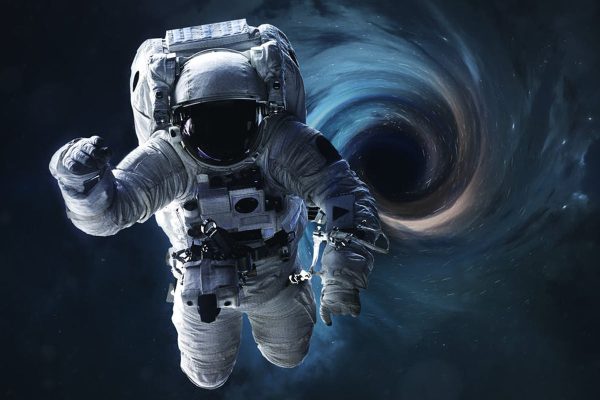

With the introduction of the second law of thermodynamics, which says that everything moves towards more chaos and entropy, we now have a real example of the presence of the “arrow of time” in physics. That is the same concept that says the movement is always forward, and the time symmetry that we saw at the level of microscopic systems and between atoms does not exist. In other words, systems at the macroscopic and large level tend to move forward, that is, from less entropy to more entropy. However, such a preference does not exist at the microscopic level.
All the molecular interactions in the room, all those innumerable minor collisions in the direction of splitting or forming molecular bonds, do not care less about time, and the past and the future are the same for them. However, the total collective behaviour of a system always moves from low entropy to high entropy and destroys time symmetry.
So can we say that entropy is related to time? Does our experience of time depend on the second law of thermodynamics?
I wish the matter would end here, But the fact is that we do not know the answer for sure. Although the idea of entropy is related to the time of the mid-1800s and almost simultaneously with the discovery of the concept of entropy, no one has been able to prove it yet.
Because the nature of the second law of thermodynamics is statistical and has nothing to prove, we’ve never seen a system that violates it, except in science fiction movies. It’s true that for this statistic to be broken. For example (for example, all the molecules in a room want to gather in one corner of the room at the same time), it might be necessary May trillions of years have passed since the age of the universe. Still, physicists do not like to apply a fundamental issue such as the arrow of time to a statistical process.
Entropy is the world of statistics and probabilities; There is no scientific proof.
As it turns out, physics has not been able to add as much helpful information to the subject of time travel as we had hoped. When it comes to entropy, there’s still nothing better than “Hey! What an interesting coincidence!” We have not arrived because everything is examined from the statistical aspect and probabilities, not solid and indisputable mathematical equations. Finally, maybe one day, we can theoretically create a time machine or a closed time curve that does not contradict the laws of physics. Perhaps we’ll discover a way to create a wormhole or find a cylinder in the pantry of an old house that goes on forever, and we can travel back in time by moving along it.
Or maybe not. We will realize that all these efforts are futile. We will be able to find such a strong scientific connection between the passage of time and the increase of entropy that it will stop us from continuing to try to build a time machine. Perhaps in the future, we will be able to find a clue in physics where the arrow of time is well explained and finally find a convincing answer to why time travel is forbidden.
But the unknowns make the discussion of time travel so fascinating. Whatever the answer to this question is, in this way, we learn new things about physics and how we know; Maybe one of these points will finally lead us to build a time machine!
via:Livescience, Arstechnia


You may like
Physics
Recording the first X-ray image of an atom with a “quantum needle”
Published
11 months agoon
05/06/2023

Recording the first X-ray image of an atom with a “quantum needle”. For the first time, Ohio University scientists have managed to record the first X-ray image of an atom using a quantum needle.
Recording the first X-ray image of an atom with a “quantum needle”
A group of researchers led by Professor Saw Wai Hla from Ohio University’s School of Physics has captured the first X-ray image of an atom, allowing scientists to study materials and their chemical states with greater clarity than ever before.
Taking pictures of atoms is nothing new. Scientists have been able to do this for years with scanning probe microscopes.
Read More: A new type of quantum entanglement discovered
Scanning probe microscopes use a sharp, electrically charged, atomically charged needle tip to probe the surfaces of materials at the nanoscale, thanks to quantum mechanical interactions that cause electrons to flow between the tip and atoms on the surface. Scanning probe microscopes (SPM: Scanning probe microscope) use a probe that moves on the sample to check the surface of the samples. By using these microscopes, in addition to surface topography, it is possible to obtain information about friction, magnetization, thermal properties, and elasticity of the surface, which cannot be obtained using other methods. In this microscope, the tip of a healthy and ideal probe is very sharp, so that only one atom can fit in its tip. Therefore, it has a very high sensitivity, and due to its very small dimensions, it can detect the smallest deviations or heights on the surface of the sample in the range of nanometers, and using the equipment and software in the device, the obtained data can be displayed as an image on the screen.
Many scanning probe microscopes can take a large number of images simultaneously. The method of using these interactions to obtain an image is generally called a “mode”. Resolution varies somewhat with each different technique, but some techniques achieve impressive atomic resolution. This is largely due to the fact that electrical pressure actuators can execute motion with precision at the atomic level, or even better, at the electron level.
But the constant problem in using scanning probe microscopes is the resolution of these images. Not only do scientists want to see atoms, but they also want to know about their chemical state on a single-atom scale, and that requires the use of X-rays, but current X-ray-based devices can only measure up to one autogram, or one-millionth of a trillionth. Analyze the gram, which consists of about 10,000 atoms. That’s not much at the atomic level, but it’s still too much for scientists.
To overcome this problem, Ohio University researchers embedded iron and terbium atoms in a matrix of ring-shaped supermolecules. They then used a technique called synchrotron X-ray scanning tunneling microscopy (SX-STM), which combines the basic mechanics of a scanning probe microscope with X-rays produced by an atomic accelerator called a synchrotron.
This aggregation produces an X-ray spectrum that records how the X-rays are absorbed by the electrons mentioned at the surface of the nucleus.


“Atoms can be imaged normally with scanning probe microscopes, but without X-rays, you can’t tell what they’re made of,” says Professor High Law.
He added: “We can now precisely identify the type of a particular atom and we can simultaneously measure its chemical state.” Once we can do this, we can trace materials down to the size of an atom. This will have a huge impact on environmental science and medicine, and maybe even find a cure that can have a huge impact on humanity. This discovery will revolutionize the world.
This research was published in the journal Nature.
Physics
Water play in the space station is not just fun and games
Published
1 year agoon
14/03/2023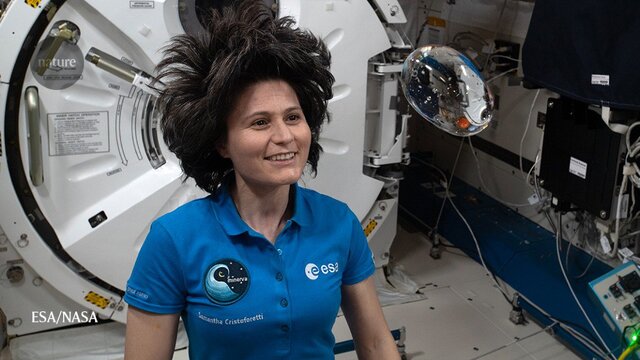

Water play in the space station is not just fun and games
In this artice we’re going to read about why water play in the space station is not just fun and games .In an interview with Nature magazine, he said about his job: I am an astronaut of the European Space Agency. Last year, I spent five months—from late April to mid-October—on the International Space Station (ISS), with the last month as station commander. Before returning to the field, my team and I took some time to play with the water. Here, inside the International Space Station, I show how water behaves in zero gravity.
There are a few tricks you can use to make sure the water stays where you want it. Surface tension holds the water bubble together, and you can move it by gently pulling on it using a straw or blowing on it. If the bubble is small enough, you can drink it. We recycle all the water inside the spacecraft.
Weightlessness is not only exciting but also an opportunity to study fundamental physics. There is a lot of research on fluid dynamics in space stations. A study that I personally participated in deals with the loosening behavior of different types of liquids and mixtures of liquids and gases in containers. The results are very important for the design of fuel tanks, especially for space applications.
Read More: Release of the first images of the space exploration program by “James Webb”.
This photo was taken in the Japanese test module. It’s the largest single module on the ISS, so we often use it to talk to the media or school students. When we communicate with them, we use things like the balls behind my head that are models of the planets and the moon. The round thing behind me is the module airlock. We use it to deploy satellites as well as hardware like scanners for science experiments.
This was the second time I went to the International Space Station. I quickly adapt to the space and enjoy the feeling of weightlessness very much. It’s much harder for me to come back down to earth.
I don’t know when I will go there again. We’ll see how the US-led Artemis program to return humans to the moon evolves over the next decade. Maybe I will get another chance.
Cristoferti was a member of the Crew-4 mission carried out by SpaceX. At that time, he arrived at the space station with the “Dragon” capsule to begin his 6-month stay on April 27. It should be mentioned that the “Cro-4” mission was the second space flight of “Cristoforti”. He previously stayed on the space station from November 2014 to June 2015.


Why does time move forward? No matter how ambiguous we are about the phenomenon of time, we agree on one thing, and that is that time always moves forward.
Why does time move forward?
Recently, a group in Australia has investigated the category of moving time forward and how it occurs. Before this, it was thought to be one of the fundamental principles of the natural world, but apparently there is a more important reason for this.
We all know that time only moves forward. No matter how many attempts have been made to change it, we know that broken glass will never repair itself and people will never be young again after aging. There are many hypotheses for the cause of this phenomenon, but for a long time, it has been thought that this one-way movement is one of the fundamental and integral parts of nature.
But based on new research conducted by Joan Vaccaro of Griffith University in Australia, it is said that this is not the main issue, and there is probably a deeper and more solid reason for time to move forward. In other words, it can be said that there must be a very careful difference between two different time directions. These two directions are actually the past and the future, and there is a factor that always leads us to the future and the opposite never happens.
Let’s back up for a second. It seems that this category is one of the most exciting and unimaginable aspects of physics. The mystery of time seems ambiguous because the forward movement of time is important in human life. But if we look at them individually at the atomic and molecular scale, then the movement of time forward or backward will not make much of a difference for these particles, and the particles will continue to behave regardless of the movement of time forward or backward.
Read More: What is mazut and what are its disadvantages for humans and the environment?
We should keep in mind that our main discussion here is not about space, because you shouldn’t expect that moving objects in space won’t change their location anyway. Therefore, scientists believed for a long time that there must be a basic reason for the expansion of the universe as time moves forward, and they did not imagine this for the category of space itself. This view is actually known as the asymmetry between space and time. The best example to express inconsistency is that the equations of the laws of motion and stability have inhomogeneous functions in time and space. Vaccaro says:
In the relationship between space and time, it is easier to understand and receive space; Because space is something that simply exists. But time is something that always pushes us forward.
His new plan states that it is possible that the two mentioned directions for time (forward and backward) are not the same at all. Vaccaro continues: Experiments conducted on subatomic particles in the last fifty years show that nature does not behave the same in dealing with these two directions of time. Among these, we can especially mention the subatomic particles called B and K mesons, which exhibit anomalous behaviors in terms of time direction.
K and B mesons are very small subatomic particles that cannot be examined without the help of some advanced tools. But the evidence of their different behavior according to the time direction effective on them shows that the reason for this difference, instead of being related to a fundamental part of nature’s behavior, may be due to the direction in which we are moving in time. We are walking. Vaccaro explains in this context: As we move forward in time, there will always be some backward bounce, like the effects of motional instability, and in fact, this backward motion is what I intend to measure using the B and K mesons.
To carry out this research, Ms. Vaccaro rewrote the equations of quantum mechanics, taking into account that the nature of time will not be the same in two directions, and the results showed that the calculations performed can accurately explain the mechanism of our world. Vaccaro said about this: When we included this complex behavior in the model of the universe, we realized that the universe moves from a fixed state in one moment to moment-to-moment and continuous changes. In other words, this difference in the two directions of time seems to be the reason for forcing the universe to move forward.
If this issue is proven, it will mean that we have to rethink and revise our understanding and acceptance of the category of time passage and the equations affected by it. But on the other hand, this achievement may lead to new insights and findings about the more strange aspects of time. Vaccaro said in the end: Understanding how time passes and evolves brings us to a completely new perspective on the natural foundations of the phenomenon of time itself. Also, in this way, we may be able to get a better understanding and reception of amazing and exciting ideas such as traveling to the past.
Vaccaro’s calculations have been published in the Journal of Physical and Mathematical Engineering Sciences.


What is an exoplanet? Everything you need to know


Seven surprising discoveries about the planet Mercury


Why there is no gaseous moon in solar system?


The strangest things that can happen to humans in space


Motorola Edge 50 Ultra review


The secret of the cleanest air on earth has been discovered


Asus Zenbook 14 OLED laptop review


Motorola Edge 50 Pro


How extinct animals could be brought back from death?


Healing diabetic wounds with bacteria-killing hydrogel
Popular
-



 Technology9 months ago
Technology9 months agoWho has checked our Whatsapp profile viewed my Whatsapp August 2023
-



 Technology10 months ago
Technology10 months agoHow to use ChatGPT on Android and iOS
-



 Technology9 months ago
Technology9 months agoSecond WhatsApp , how to install and download dual WhatsApp August 2023
-



 Technology11 months ago
Technology11 months agoThe best Android tablets 2023, buying guide
-



 Humans1 year ago
Humans1 year agoCell Rover analyzes the inside of cells without destroying them
-



 AI1 year ago
AI1 year agoUber replaces human drivers with robots
-



 Technology10 months ago
Technology10 months agoThe best photography cameras 2023, buying guide and price
-



 Technology11 months ago
Technology11 months agoHow to prevent automatic download of applications on Samsung phones



